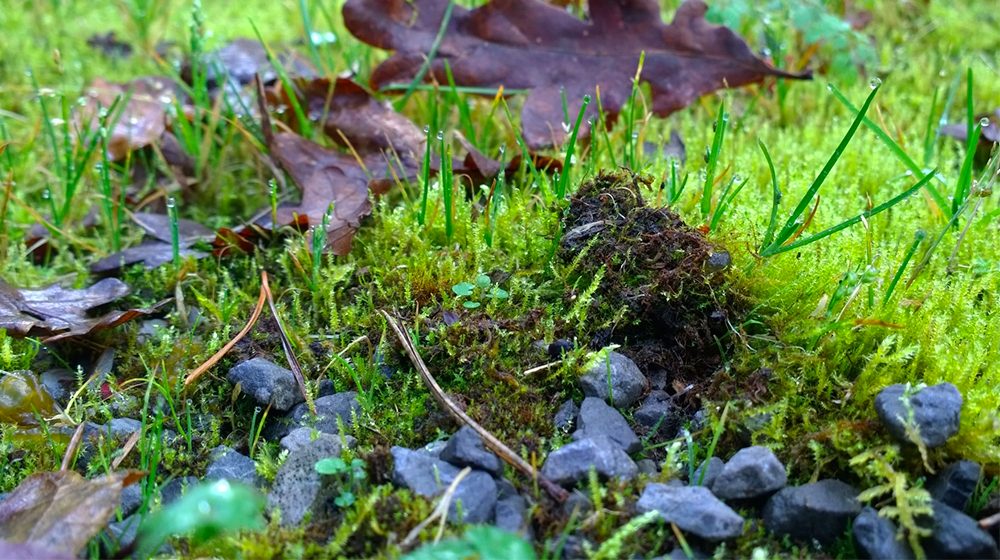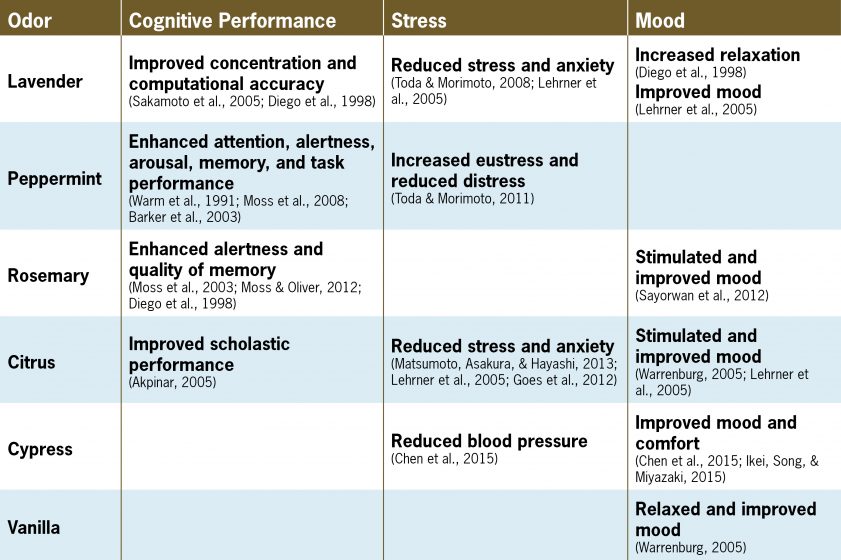When you walk outside after a summer rainstorm, you know it when it hits you: that distinctly earthy, musty, yet crisp scent that flows with optimism and a desire to be in nature as you take a long, deep breath. It is the smell of rain, known as petrichor, and it is released as raindrops hit the ground, spreading odor molecules from the soil into the air.
Biophilia, humanity’s innate biological connection with nature, is utilized in biophilic design, which incorporates nature into the built environment to improve our health and wellbeing. Specifically, a Non-Visual Connection with Nature (Pattern 2 of the 14 Patterns of Biophilic Design) provides an exciting opportunity for design to further enhance our perception of a space. Biophilic odors, or olfactory sensory stimuli that reflect nature, have physiological effects (e.g., arousal and improved immune function), as well as profound associations with memory and emotion, impacting both the body and mind.

Odor-associative learning
Olfaction, or the sense of smell, was the first sense to evolve in animal cells and arose as a way to recognize and respond to chemicals in the environment [1]. The human threshold for sensing some odors is impressively low—the earthy scent of geosmin (the compound that assists the release of petrichor) can be detected at concentrations under ten parts per trillion [2]—and the estimated number of odors that humans can detect ranges from a conservative 5,000 [3] to 1 trillion [4]. Odors are processed very quickly by the human body compared to other stimuli; odorous molecules bind to olfactory receptors in the lining of the nose and send signals through the olfactory nerve directly to the limbic system, the network in the brain responsible for emotion and memory [1].
This intimate anatomical connection between stimulus and response makes olfaction a powerful mnemonic trigger, playing an important role in human cognition, behavior, and memory [5]. In odor-associative learning, an olfactory stimulus becomes linked to an emotion, memory, behavior, or physiological response through experience [1]. That is why smelling bacon may make your mouth water or why the scent of charcoal may remind you of a summer camp cookout. A body of research indicates that most responses to odors (Table 1) are due to associative learning and have measurable effects on cognitive performance, stress, and mood.

According to a study by Glass et al., odors associated with nature (e.g., summer air) have been shown to evoke positive responses, while those associated with urban environments (e.g., disinfectants) evoked negative responses [6]. For example, the scent of summer air not only improved mood, but also was identified by study participants to be associated with meadows, grass clippings, and tomatoes. Odor preference was also linked with physical response, which was largely due to associative memory. Studies on Shinrin-yoku, or Japanese forest bathing, present evidence of the physiological benefits (e.g., lower cortisol concentrations, pulse rate, blood pressure) of spending time in wooded areas compared to urban areas [7, 8]. Other opportunities exist in the scope of non-plant-based natural scents such as seawater or clay.

Designing for positive psychophysiological responses to natural scents can improve occupant health, productivity, and performance, translating to economic savings and enhanced well-being. In The Economics of Biophilia, Terrapin Bright Green explains that much of an office’s cost is devoted to salary and benefits, so employee health is a smart investment. The main factors of productivity loss in the workplace (e.g., poor focus, negative mood) may be lessened with proper implementation of olfactory stimuli such as using peppermint to improve focus and performance [10]. Similarly, an improved learning experience in schools may be achieved with odors like rosemary, to enhance alertness and cognitive performance [11, 12]. In high-traffic open settings like offices and schools, generally pleasant odors in low concentrations may be most effective in improving well-being for the most people.
Healthcare facilities such as hospitals or dentist offices can encourage more comfortable experiences by incorporating odors such as lavender to alleviate anxiety, reduce agitation in patients with severe dementia, or lessen the demand for postoperative painkillers [13, 14, 15]. These environments, with a relatively high amount of control over localized air quality, may cater odors to personal preferences or associations, creating a more effective healing space. Faster recovery times mean happier patients and reduced costs.

Design strategies
As forms of both Nature in the Space and Natural Analogues, olfactory stimuli may be incorporated into design in several ways to support a biophilic experience:
- Odorous building materials such as cedarwood can be used to integrate olfactory stimuli directly into the exposed structure or finishes of the space, contributing to its ambient scent.
- Mechanical systems may be programmed to appropriately administer odors via airflow to specific areas at specific times.
- Vegetated areas such as herb gardens, window boxes, water features, and plant-lined walkways enhance spaces by designing around the source of the odor and providing access to physical interactions with nature.
Design should consider the use of odor as one of many strategies to be integrated into the ecological, utilitarian, and experiential context of a space. A multi-sensory experience amplifies the benefits of a scent and connects it with other patterns of biophilic design. The olfactory experience may be enhanced by Visual Connection with Nature, which gives context to odor; Thermal & Airflow Variability, which distributes odor throughout space; and Presence of Water and Material Connection with Nature, which each contribute to ambient odor. Olfactory stimuli may also contribute to Non-Rhythmic Sensory Stimuli with stochastic exposure to natural scents and to Mystery, which has conventionally been reserved for the visual experience, by attracting individuals using far-reaching scents. The interplay of multiple senses is essential in designing for people with limited vision or mobility, an idea realized by the Universal Design movement.

“Every touching experience of architecture is multi-sensory; qualities of space, matter and scale are measured equally by the eye, ear, nose, skin, tongue, skeleton, and muscle. Architecture strengthens the existential experience, one’s sense of being in the world.”
— Juhani Pallasmaa
Implementation opportunities
Olfactory stimuli, with their unique chemical properties and ability to evoke powerful emotional responses, provide challenges and thus opportunities during design implementation. Thoughtful design choices can create a supportive user experience by engaging these aspects of human nature:
- Subjective associations. Variation exists in responses to odors within and across groups of people. Some scents (e.g., vanilla, decomposition) elicit universal positive or negative responses that may be hardwired into our brains. Others vary across cultures (e.g., wintergreen is associated with candy in the U.S., but with medicine in the U.K.) with different histories, foods, and ecologies [16, 1]. In addition, subjectivity in personal associations of odors with individual life experiences is exceptionally important; an odor may elicit drastically different responses in different people. Scents with unique personal meaning may evoke positive responses or they may be distracting. Designers should take care to be familiar with their clients’ needs in order to make effective use of odor responses.
- Establishment and flexibility of associations. Most emotional, behavioral, and mnemonic associations are established when an odor is first encountered, which usually happens early in life [1]. Designing for these associations—often shared among people (e.g., preference for vanilla)—may be more effective than attempting to create new ones, which may turn out to be negative. Designers should also note the opportunity of improving existing associations with odors and, consequently, a space.
- Allergies and ability. Sensitivities to odors and allergens, as well as varying abilities to detect scents, are factors that should be considered for proper implementation. Possible strategies include using hypoallergenic scents (i.e., natural essential oils rather than synthetic fragrances), controlled concentrations, or containment to personal spaces. Further research on odor thresholds, conscious odor perception, and ability to focus on multiple odors will create more design opportunities.
- Habituation. Over time, the novelty and emotional response to familiar odors diminish (e.g., eventual numbness to the scent of your own cologne), defaulting to general physiological and preference-related responses [1]. Intensity, persistence, and duration of exposure needed for response vary among odors. Strategic design can help prevent a scent from fading into the background by providing access to physical interaction with its source or by releasing a scent stochastically.

Looking forward
As a Non-Visual Connection with Nature, the olfactory experience is often overlooked in the built environment, yet it has a profound impact on the perception of our surroundings. With such potent associated memories, emotions, and physical reactions, odors open new doors for biophilic design. While ongoing research will explain the unknowns of perception and the human experience, it will ultimately be up to designers and planners to make use of these insights and create supportive environments that better connect us to nature.
Sam Gochman
New York City
This essay is posted with permission from Terrapin Bright Green and originally appeared on http://www.terrapinbrightgreen.com/blog/ on May 9, 2016.
*Feature and header image copyright Barklay/Flickr.
References
- Herz, R. (2002). Influence of odors on mood and affective cognition. In C. Rouby, B. Schaal, M. Georgescu, & C. Perederco (Eds.), Olfaction, taste, and cognition (160-177). Cambridge University Press.
- Jiang, J., He, X., & Cane, D. E. (2007). Biosynthesis of the earthy odorant geosmin by a bifunctional Streptomyces coelicolor enzyme. Nature chemical biology, 3(11), 711-715.
- Gerkin, R. C., & Castro, J. B. (2015). The number of olfactory stimuli that humans can discriminate is still unknown. Elife, 4, e08127.
- Bushdid, C., Magnasco, M. O., Vosshall, L. B., & Keller, A. (2014). Humans can discriminate more than 1 trillion olfactory stimuli. Science, 343(6177), 1370-1372.
- Willander, J., & Larsson, M. (2007). Olfaction and emotion: The case of autobiographical memory. Memory & cognition, 35(7), 1659-1663.
- Glass, S. T., Lingg, E., & Heuberger, E. (2014). Do ambient urban odors evoke basic emotions? Applied Olfactory Cognition, 158.
- Park, B. J., Tsunetsugu, Y., Kasetani, T., Kagawa, T., & Miyazaki, Y. (2010). The physiological effects of Shinrin-yoku (taking in the forest atmosphere or forest bathing): evidence from field experiments in 24 forests across Japan. Environmental health and preventive medicine, 15(1), 18-26.
- Tsunetsugu, Y., Park, B. J., & Miyazaki, Y. (2010). Trends in research related to “Shinrin-yoku”(taking in the forest atmosphere or forest bathing) in Japan. Environmental health and preventive medicine, 15(1), 27-37.
- Li, Q., Kobayashi, M., Wakayama, Y., Inagaki, H., Katsumata, M., Hirata, Y., … & Ohira, T. (2009). Effect of phytoncide from trees on human natural killer cell function. International journal of immunopathology and pharmacology, 22(4), 951-959.
- Barker, S., Grayhem, P., Koon, J., Perkins, J., Whalen, A., & Raudenbush, B. (2003). Improved performance on clerical tasks associated with administration of peppermint odor. Perceptual and Motor Skills, 97(3), 1007-1010.
- Sayorwan, W., Ruangrungsi, N., Piriyapunyporn, T., Hongratanaworakit, T., Kotchabhakdi, N., & Siripornpanich, V. (2013). Effects of inhaled rosemary oil on subjective feelings and activities of the nervous system. Scientia pharmaceutica, 81(2), 531.
- Moss, M., & Oliver, L. (2012). Plasma 1, 8-cineole correlates with cognitive performance following exposure to rosemary essential oil aroma. Therapeutic advances in psychopharmacology, 2(3), 103-113.
- Lehrner, J., Marwinski, G., Lehr, S., Johren, P., & Deecke, L. (2005). Ambient odors of orange and lavender reduce anxiety and improve mood in a dental office. Physiology & Behavior, 86(1), 92-95.
- Perry, N., & Perry, E. (2006). Aromatherapy in the management of psychiatric disorders. CNS drugs, 20(4), 257-280.
- Kim, J. T., Ren, C. J., Fielding, G. A., Pitti, A., Kasumi, T., Wajda, M., … & Bekker, A. (2007). Treatment with lavender aromatherapy in the post-anesthesia care unit reduces opioid requirements of morbidly obese patients undergoing laparoscopic adjustable gastric banding. Obesity surgery, 17(7), 920-925.
- Candau, J. (2004). The olfactory experience: constants and cultural variables. Water Science & Technology, 49(9), 11-17.
Table 1 References
Sakamoto, R., Minoura, K., Usui, A., Ishizuka, Y., & Kanba, S. (2005). Effectiveness of aroma on work efficiency: lavender aroma during recesses prevents deterioration of work performance. Chemical senses, 30(8), 683-691.
Diego, M. A., Jones, N. A., Field, T., Hernandez-Reif, M., Schanberg, S., Kuhn, C., … & Galamaga, R. (1998). Aromatherapy positively affects mood, EEG patterns of alertness and math computations. International Journal of Neuroscience, 96(3-4), 217-224.
Toda, M., & Morimoto, K. (2008). Effect of lavender aroma on salivary endocrinological stress markers. Archives of oral biology, 53(10), 964-968.
Warm, J. S., Dember, W. N., & Parasuraman, R. (1991). Effects of olfactory stimulation on performance and stress. J. Soc. Cosmet. Chem, 42, 199-210.
Moss, M., Hewitt, S., Moss, L., & Wesnes, K. (2008). Modulation of cognitive performance and mood by aromas of peppermint and ylang-ylang.International Journal of Neuroscience, 118(1), 59-77.
Toda, M., & Morimoto, K. (2011). Evaluation of effects of lavender and peppermint aromatherapy using sensitive salivary endocrinological stress markers. Stress and Health, 27(5), 430-435.
Moss, M., Cook, J., Wesnes, K., & Duckett, P. (2003). Aromas of rosemary and lavender essential oils differentially affect cognition and mood in healthy adults. International Journal of Neuroscience, 113(1), 15-38.
Akpinar, B. (2005). The effects of olfactory stimuli on scholastic performance. The Irish Journal of Education/Iris Eireannach an Oideachais, 86-90.
Matsumoto, T., Asakura, H., & Hayashi, T. (2014). Effects of olfactory stimulation from the fragrance of the Japanese citrus fruit yuzu (Citrus junos Sieb. ex Tanaka) on mood states and salivary chromogranin A as an endocrinologic stress marker. The Journal of Alternative and Complementary Medicine, 20(6), 500-506.
Goes, T. C., Antunes, F. D., Alves, P. B., & Teixeira-Silva, F. (2012). Effect of sweet orange aroma on experimental anxiety in humans. The Journal of Alternative and Complementary Medicine, 18(8), 798-804.
Warrenburg, S. (2005). Effects of fragrance on emotions: moods and physiology. Chemical Senses, 30(suppl 1), i248-i249.
Chen, C. J., Kumar, K. J., Chen, Y. T., Tsao, N. W., Chien, S. C., Chang, S. T., … & Wang, S. Y. (2015). Effect of Hinoki and Meniki Essential Oils on Human Autonomic Nervous System Activity and Mood States. Natural product communications, 10(7), 1305-1308.
Ikei, H., Song, C., & Miyazaki, Y. (2015). Physiological effect of olfactory stimulation by Hinoki cypress (Chamaecyparis obtusa) leaf oil. Journal of physiological anthropology, 34(1), 1.












Add a Comment
Join our conversation